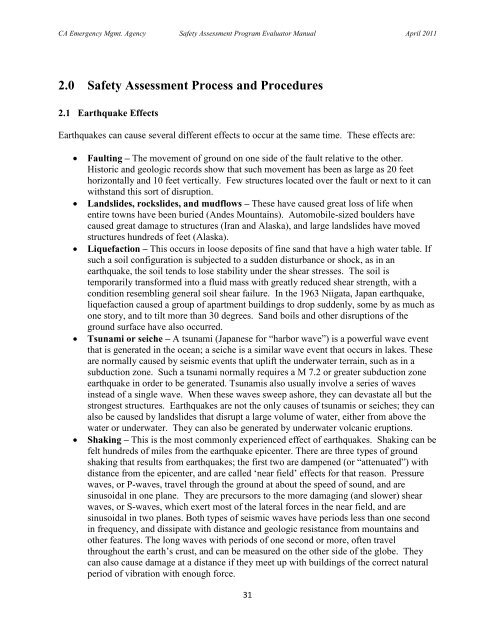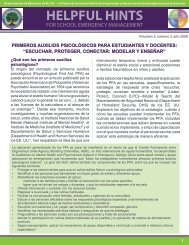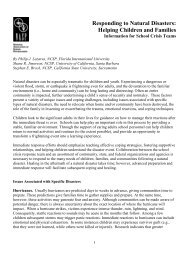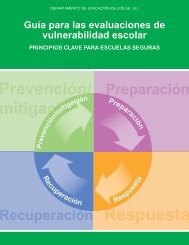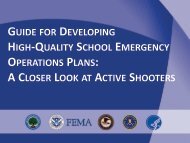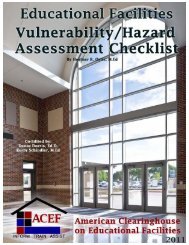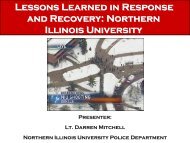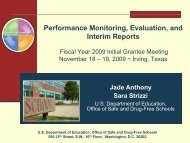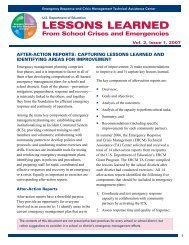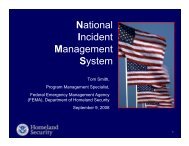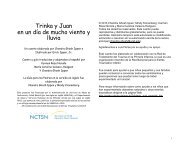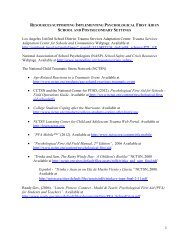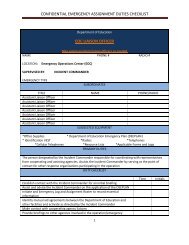Safety Assessment Program Evaluator Student Manual
Safety Assessment Program Evaluator Student Manual
Safety Assessment Program Evaluator Student Manual
Create successful ePaper yourself
Turn your PDF publications into a flip-book with our unique Google optimized e-Paper software.
CA Emergency Mgmt. Agency <strong>Safety</strong> <strong>Assessment</strong> <strong>Program</strong> <strong>Evaluator</strong> <strong>Manual</strong> April 20112.0 <strong>Safety</strong> <strong>Assessment</strong> Process and Procedures2.1 Earthquake EffectsEarthquakes can cause several different effects to occur at the same time. These effects are:Faulting – The movement of ground on one side of the fault relative to the other.Historic and geologic records show that such movement has been as large as 20 feethorizontally and 10 feet vertically. Few structures located over the fault or next to it canwithstand this sort of disruption.Landslides, rockslides, and mudflows – These have caused great loss of life whenentire towns have been buried (Andes Mountains). Automobile-sized boulders havecaused great damage to structures (Iran and Alaska), and large landslides have movedstructures hundreds of feet (Alaska).Liquefaction – This occurs in loose deposits of fine sand that have a high water table. Ifsuch a soil configuration is subjected to a sudden disturbance or shock, as in anearthquake, the soil tends to lose stability under the shear stresses. The soil istemporarily transformed into a fluid mass with greatly reduced shear strength, with acondition resembling general soil shear failure. In the 1963 Niigata, Japan earthquake,liquefaction caused a group of apartment buildings to drop suddenly, some by as much asone story, and to tilt more than 30 degrees. Sand boils and other disruptions of theground surface have also occurred.Tsunami or seiche – A tsunami (Japanese for “harbor wave”) is a powerful wave eventthat is generated in the ocean; a seiche is a similar wave event that occurs in lakes. Theseare normally caused by seismic events that uplift the underwater terrain, such as in asubduction zone. Such a tsunami normally requires a M 7.2 or greater subduction zoneearthquake in order to be generated. Tsunamis also usually involve a series of wavesinstead of a single wave. When these waves sweep ashore, they can devastate all but thestrongest structures. Earthquakes are not the only causes of tsunamis or seiches; they canalso be caused by landslides that disrupt a large volume of water, either from above thewater or underwater. They can also be generated by underwater volcanic eruptions.Shaking – This is the most commonly experienced effect of earthquakes. Shaking can befelt hundreds of miles from the earthquake epicenter. There are three types of groundshaking that results from earthquakes; the first two are dampened (or “attenuated”) withdistance from the epicenter, and are called „near field‟ effects for that reason. Pressurewaves, or P-waves, travel through the ground at about the speed of sound, and aresinusoidal in one plane. They are precursors to the more damaging (and slower) shearwaves, or S-waves, which exert most of the lateral forces in the near field, and aresinusoidal in two planes. Both types of seismic waves have periods less than one secondin frequency, and dissipate with distance and geologic resistance from mountains andother features. The long waves with periods of one second or more, often travelthroughout the earth‟s crust, and can be measured on the other side of the globe. Theycan also cause damage at a distance if they meet up with buildings of the correct naturalperiod of vibration with enough force.31


